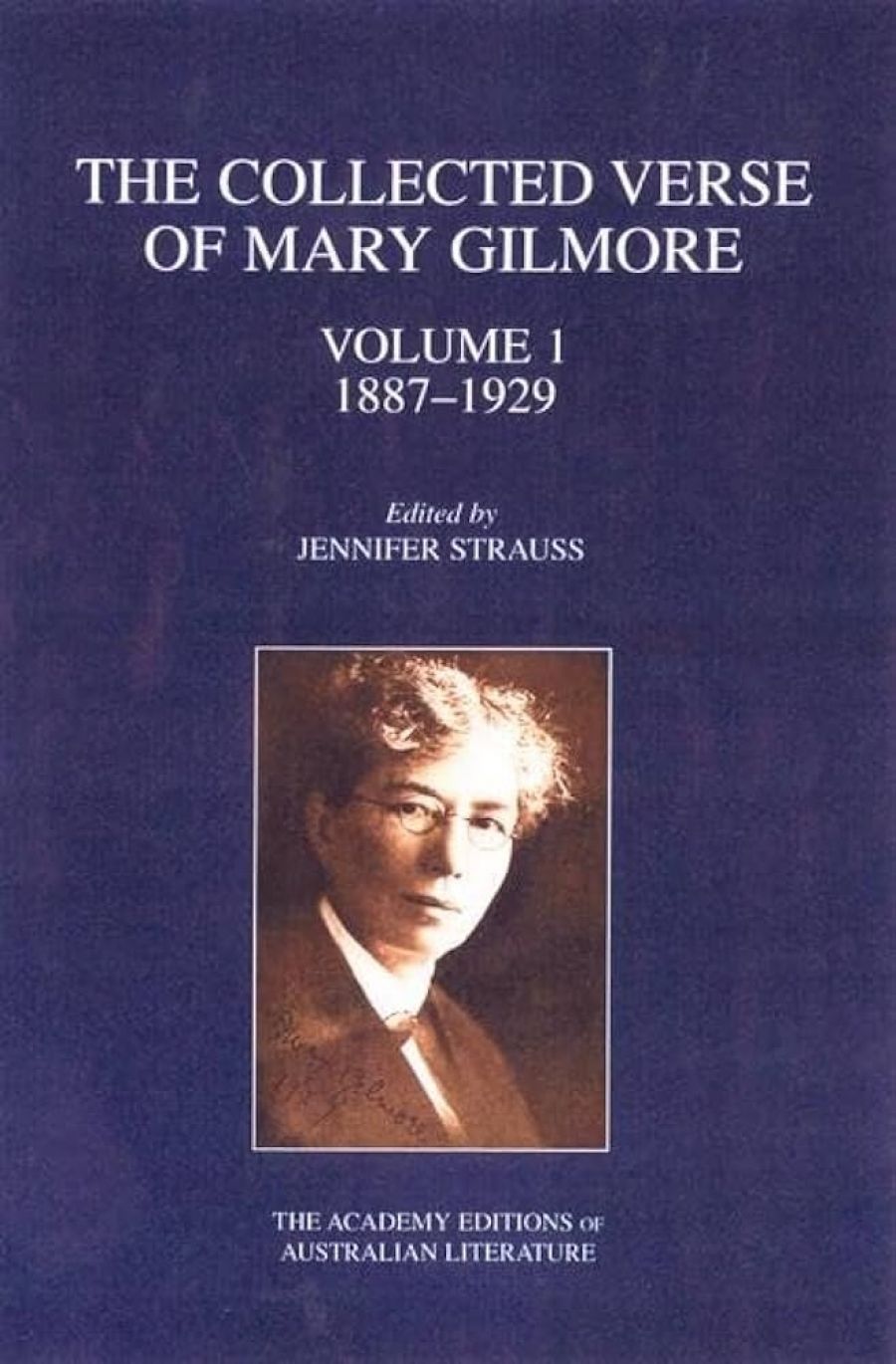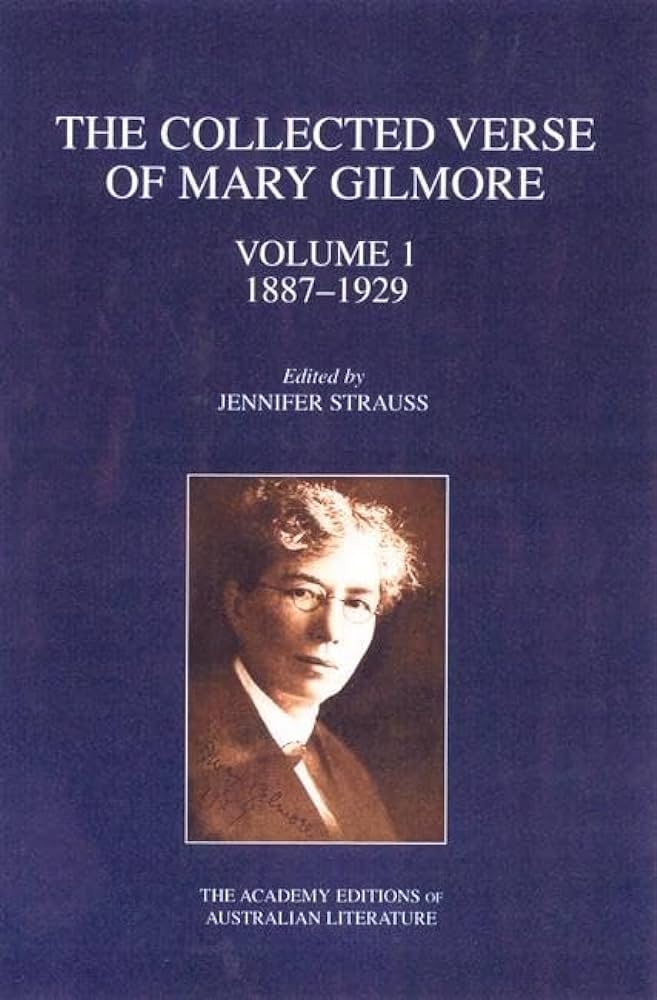
- Free Article: No
- Contents Category: Australian Poetry
- Review Article: Yes
- Article Title: The Singing Voice
- Online Only: No
- Custom Highlight Text:
Mary Gilmore is one of the most acclaimed figures in Australian writing. A cultural icon, she appears in important paintings and sculptures and on postage stamps, not to mention the ten-dollar note. Her biography has been published, her letters collected, and now the first volume of her complete poems, edited by Jennifer Strauss, has appeared in the prestigious Academy Editions of Australian Literature. No other Australian poet except Henry Lawson has received quite the degree of attention that Gilmore has been accorded. Longevity certainly had something to do with her fame: she was a living link between the colonial Australia she was born into and the Australia of the 1960s that saw her passing. Like Lawson’s, her life and work are written into Australian history; and she too is inextricably associated with the legend of the 1890s. She never quite achieved Lawson’s popularity as a writer, but this edition makes it clear that her fame was truly earned, not merely accrued. No literary reputation is ever finally fixed, or immune to criticism, but this book will help us to understand why Gilmore, Australia’s foremost woman poet during the first half of the twentieth century, came to be considered a national treasure.
- Book 1 Title: The Collected Verse Of Mary Gilmore
- Book 1 Subtitle: Volume 1 1887–1929
- Book 1 Biblio: UQP, $80 pb, 819 pp, 0702234869, $175 hb, 0702238450
- Book 1 Cover Small (400 x 600):

- Book 1 Cover (800 x 1200):

Gilmore was a prolific writer. This collection, the first of two, brings together all of her published books: Marri’d and Other Verses (1910), The Passionate Heart (1918) and The Tilted Cart (1925), and an immense amount of previously uncollected and scattered work from 1887 to 1929, including some of the little-known Tale of Tiddley Winks (1917) poems for children – one of the least studied aspects of Australian poetry. The volume is a triumph of scholarship and industry, and a real work of recuperation and restoration. It gives us new material for rereading Australian literary culture from the 1890s to the 1950s, and it will particularly add to our understanding of the 1920s and the 1930s, so often considered to be the culturally thin interwar years.
Gilmore seems to have kept almost everything she ever wrote. Those who prefer the self-critical astringencies and renunciations of a Kenneth Slessor or an A.E. Housman might feel daunted by the enormous amount of material here. It requires leisure and enthusiasm for Australian poetic culture to become absorbed in these pages, but I think that the editor was right to opt for a Collected of this kind. Gilmore was an uneven poet, but flawed or less successful poems can throw light on the more achieved pieces and can reveal her preoccupations and concerns at particular points in her writing life. A chronological arrangement gives us the full context in which her best-known and most moving poems took shape.
Gilmore, an ambitious poet, was disappointed when Tom Inglis Moore failed to include her in his Six Australian Poets (1942). Readers will be struck by the range and variety of her subject matter. Most of her poems are short lyrics, sometimes arranged as cycles or sets, and she was worried that they might be considered ‘small and sentimental’. A large proportion belongs to the older lyrical tradition that exploits the singing voice. She once said that the forms she most preferred were those of the ballad, the hymn and the folk song, and we can find various popular song forms in her work, including a couple of variations on ‘negro minstrel’ themes. But she did not want her more ‘serious and complex’ pieces overlooked. If she exploited the singing voice, she also, like her friend and contemporary Hugh McCrae, explored the use of the speaking voice – in Scottish dialect writing that draws on her family heritage – and, like another contemporary, C.J. Dennis, she tried to capture something of an Australian idiom. She wrote poems that reflect the voices she heard in the Sydney streets. If these experiments are not all successful, they have an historical and cultural interest that is only one of the justifications of the present volume.
Gilmore’s contribution to the Australian bush ballad tradition has never been fully appreciated. A reconsideration of this part of our writing, usually thought to be an exclusively male domain, is long overdue. Bush ballads written by a woman, and often from the woman’s point of view, form a considerable part of Gilmore’s work, but there are not many examples of them in the various anthologies of Australian ballads before the mid-1990s.
Gilmore certainly saw herself as a national poet. Like a number of writers of her era, she was trying to affirm an Australian tradition and a sense of confidence in an Australian identity. Like Bernard O’Dowd and Dorothea Mackellar, for instance, she was fascinated by the notion of ‘Australia’, its past, present and future. It was a subject she returned to often. Above all, she wanted to commemorate ‘the makers of Australia’. Her literary nationalism was never narrowly focused. One of the major finds that this edition makes available is the set of translations from South American poets, as well as her rare translations from the French and German. She was always trying to set up connections. The poems she dedicated or addressed to her contemporaries give a striking sense of the networks of support and encouragement that existed among the writers of that era. But if Gilmore was embedded in the life of her place and time, she drew on the whole British literary heritage to write about Australian experience. She is steeped in the stories and language of the Bible, and her poetry is full of echoes and reminiscences from contemporary poets such as W.B. Yeats, Walter de la Mare, Alice Meynell, Laurence Binyon, Ella Wheeler Wilcox, John Masefield, Rudyard Kipling and a host of others.
One of the dominant impulses in Mary Gilmore’s work was to record and preserve the fleeting moment, to hold on to images of a vanishing Australia. Now, in this authoritative new edition, we come in contact again with a vanished world that has so many threads connecting it with our own.


Comments powered by CComment